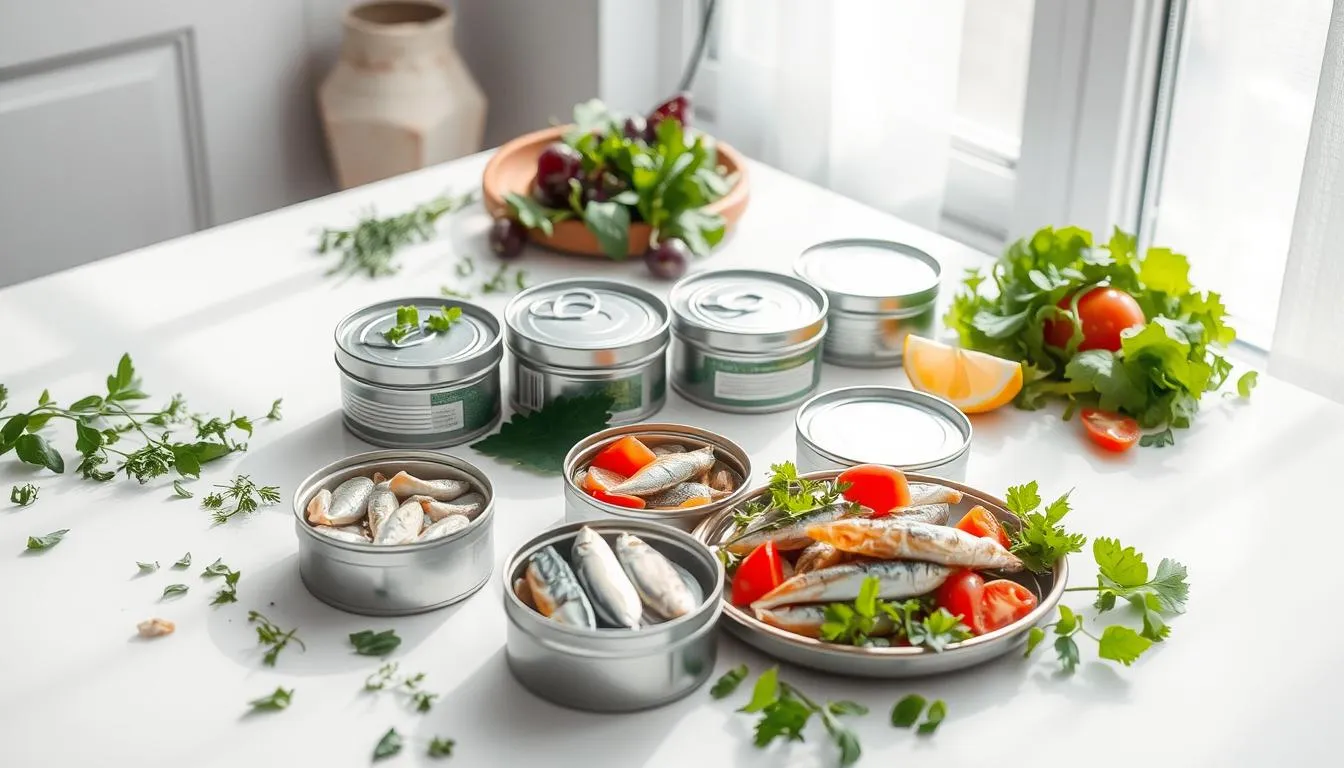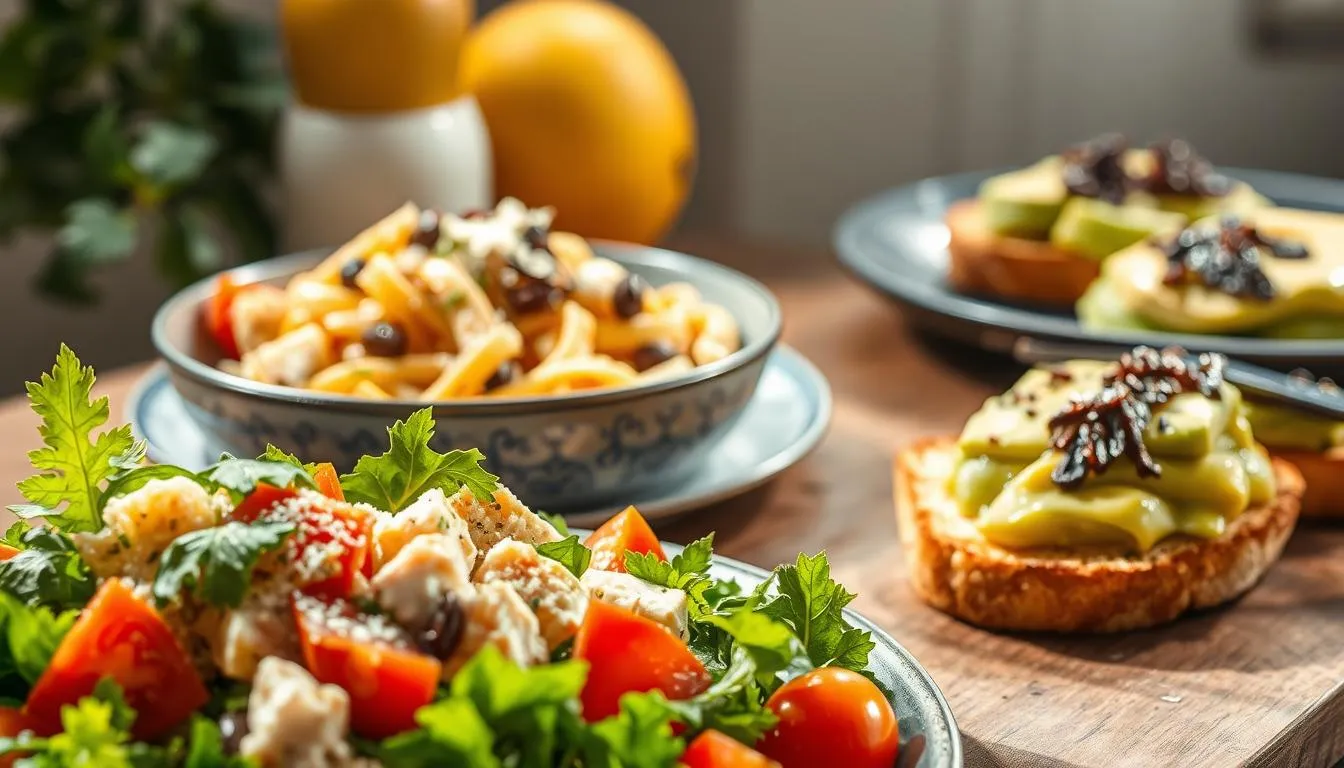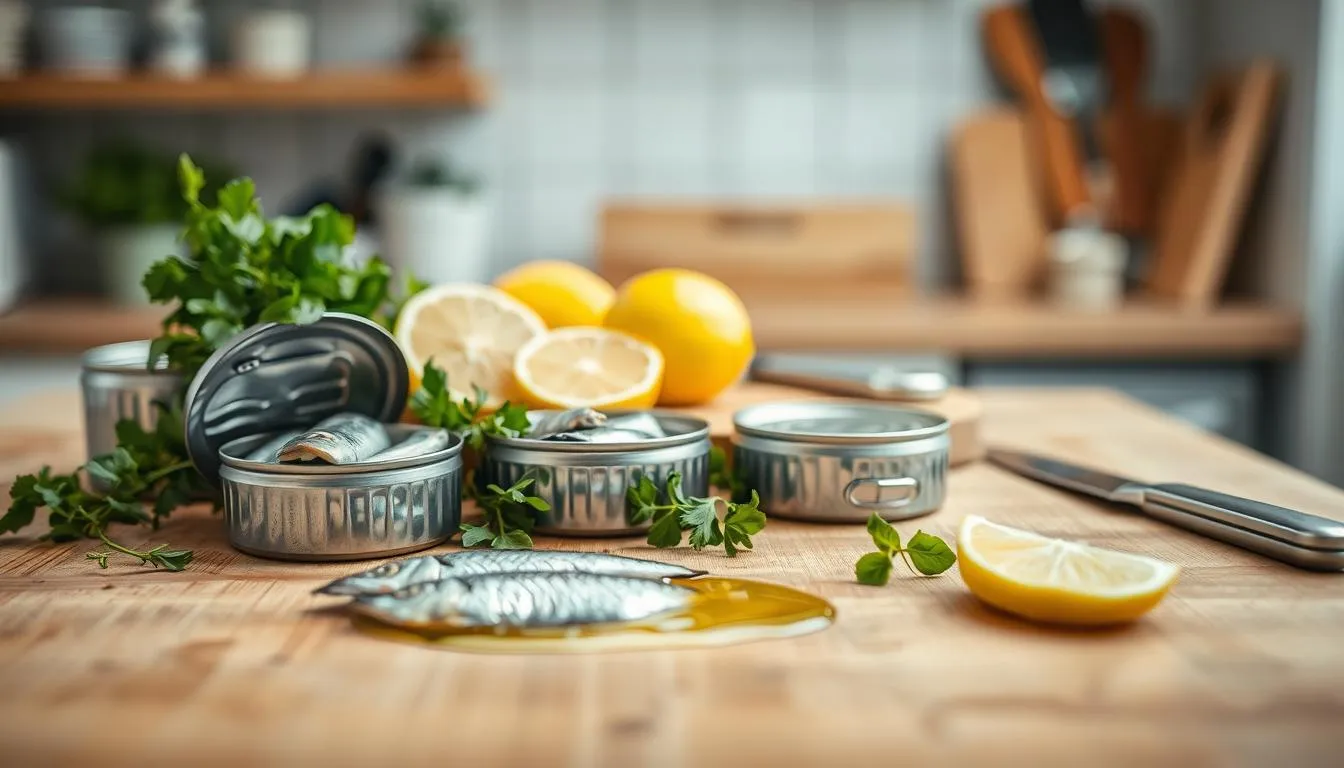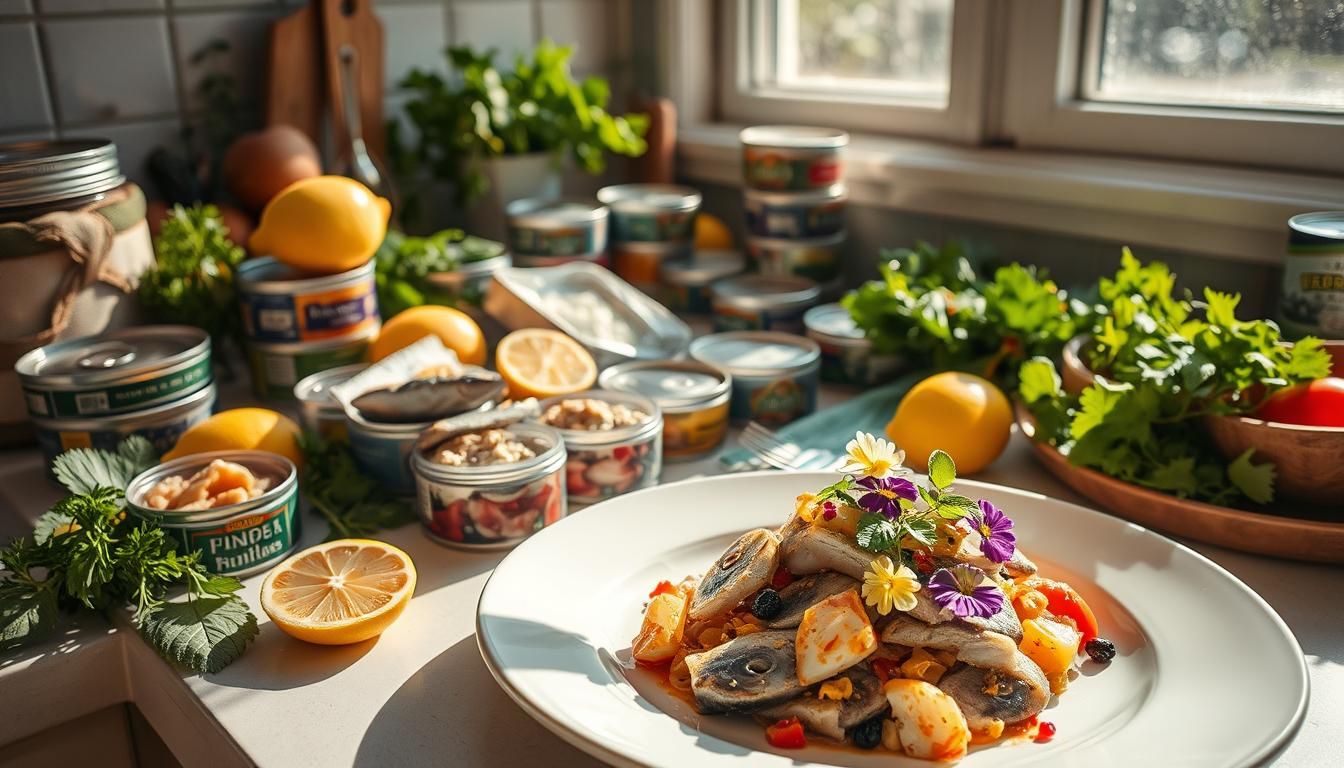There are meals that bring a memory back with one bite. I still recall my first quick dinner after a long shift: a warm crust, a tin opened with a simple, bright spread, and the relief of something tasty in minutes.
Chef Chris McDade and food editors champion these pantry staples for good reason. Theyre sustainable, affordable, and full of bold flavor.
From anchovy butter for steak to lemony sardine pt and white bean tuna salad, this list covers approachable ideas that lift canned options into memorable meals. Youll learn pantry-first tips, smart shopping cues like MSC labels, and trusted brands such as Rio Mare, Princes, and Waitrose.
This guide helps busy cooks feed family and friends without fuss, showing how simple techniques and one or two tins can deliver restaurant-worthy results at home.
Key Takeaways
- Pantry staples can be transformed into quick, flavor-forward meals.
- Look for MSC labels and brands like Rio Mare, Princes, and Waitrose for sustainable picks.
- Use the oil or brine in the tin to boost cooking and cut waste.
- Anchovies and sardines are powerful umami boosters in small amounts.
- These ideas are budget-friendly and perfect for weeknight family meals.
Why Tinned Fish Is Trending Now: Nutrition, Sustainability, and Smart Shopping
Shelf-stable tins have surged in popularity because they pack nutrition, convenience, and sustainability into one pantry staple.
Health perks are a major draw. Tuna, sardines, salmon, and anchovies deliver protein, omega-3s, vitamin D, and B12. When bones remain in salmon or sardines, you also get a calcium boost without extra ingredients.
Nutrition highlights
- Omega-3s support heart and brain health.
- High protein keeps lunches and dinners satisfying.
- Short ingredient lists usually mean better taste and fewer additives.

Smarter buys and sustainability
Look for the MSC blue tick or hook-and-line sourcing on labels. Brands like Rio Mare (no-drain tuna), Princes mackerel in sunflower oil, and Waitrose anchovy fillets in olive oil are useful examples for specific uses.
“Use the oil or brine in the tin it makes a simple sauce for pasta or a glossy finish for a photo-ready dish.”
| Product | Packing | Best use |
|---|---|---|
| Rio Mare tuna | No-drain oil | Salads, quick sandwiches |
| Princes mackerel | Sunflower oil | Hashes, toast toppers |
| Waitrose anchovy | Olive oil | Dressings, sauces |
Tinned fish recipes: easy dinners, lunches, and snacks you can make tonight
When dinner time lands and the pantry is your shortcut, a tin and a few staples can turn into something memorable.
Anchovy power-ups deliver instant umami. Whip anchovy butter for a quick steak topper, stir a bagna cauda-style sauce through pasta, or mash fillets into dressings for extra depth.
Anchovy ideas
Make a simple anchovy butter, or blend anchovy into a garlicky gremolata for roasted potatoes. These small touches lift plain meals fast.

Sardine and tuna quick meals
Sardines on toast with lemon and parsley make a bright lunch. Toss sardine tomato pasta with gremolata for a fast, photo-ready dinner.
For tuna, try a white bean salad with hard-boiled eggs or a crusty tuna melt. Leftover canned tuna hacks like stir-fried fried rice are weeknight lifesavers.
Salmon, mackerel, soups, and pasta night
Budget salmon turns into burgers or salmon-and-potato patties. Tinned mackerel becomes peppered fishcakes or a smoky leek hash.
Finish the list with soups and pasta: fold smoked trout into chowder, simmer a tomato-anchovy risotto, or cook anchovy spaghetti with chili and garlic for an easy pasta night.
Pantry-to-plate: fast ways to turn a tin into a meal
A single tin plus a few fresh staples can turn into a showstopping plate in under ten minutes. These pantry moves work for lunch, a quick dinner, or a photo-ready snack.
Toast and bagel toppers
Lemony sardine pt is a bright spread: zest, lemon juice, a pinch of Aleppo pepper, and a spoonful of the tins oil. Mash, slather on toast or a bagel, and garnish with parsley.
For a heartier bite, top warm toast with tinned mackerel and a perfectly poached egg. The runny yolk becomes an instant sauce that ties everything together.

Big salads for lunch
Build a bowl with a roasted seaweed Caesar dressing, anchovy croutons, shaved Parm, and a drizzle of olive oil from the tin for extra umami.
Toss a Spanish-leaning white bean & tuna salad with red onion, parsley, lemon, and canned tuna for a tidy, protein-rich lunch. Use no-drain tuna like Rio Mare to cut prep time.
- Keep ingredients minimal: lemon, capers, and fresh herbs lift any tin.
- Use tin oil as dressing basewhisk with vinegar or honey for instant flavor.
Pro tips for flavor, ingredients, and sustainability
Using whats already in the tin saves waste and deepens the taste of simple meals.
Use the oil and sauces in the tin for extra flavor and less waste. Whisk the oil into a quick dressing, or drizzle it into warm pasta water for a glossy finish. If a tin comes with its own sauce, pour that into the pan to build an instant baseno extra stock needed.
Balance rich, salty canned items with lemon and fresh herbs. Add crunch with toasted breadcrumbs or nuts to lift texture. Keep a small pantry kit (capers, chili flakes, Dijon, good vinegar) so each can becomes a full meal option.
Sustainability, storage, and smart buys
Look for the MSC label or hook-and-line sourcing, and favor small oily species like mackerel and sardines when possible. Brands such as Rio Mare, Princes, and Waitrose often list sourcing on the label.
| Packing | Best use | Sustainability tip |
|---|---|---|
| Oil-packed | Warm sauces, sauts, salad dressings | Use oil to reduce extra ingredients |
| Brine-packed | Light salads, cold bowls | Rinse if too salty; add fresh olive oil |
| Sauce-packed | One-pan meals, pasta bases | Pour sauce straight into pan for depth |
For more guidance on smart shopping and quick ideas, see an easy guide to tinned fish.
Conclusion
Keep a few go-to tinstuna, salmon, and mackereland a small pantry kit. With those on hand you can build a quick lunch or dinner in under 20 minutes. A tin plus lemon, herbs, and good oil unlocks salads, pasta, and fast, photo-ready plates.
Choose MSC-labeled or hook-and-line options when you can. That helps balance health, cost, and sustainability while still delivering bold flavor. Try an anchovy pasta night, sardines on toast, or a white bean salad for tomorrow.
Pick one easy recipe from this guide, make a short list, and enjoy a fast, satisfying meal tonight. Small steps in the pantry lead to big wins for food that looks and tastes great.
FAQ
What are the main health benefits of canned salmon, tuna, sardines, and mackerel?
These shelf-stable options pack high-quality protein and omega-3 fats that support heart and brain health. Salmon and sardines also deliver vitamin D, and when bones are soft (like in sardines) you get extra calcium. Theyre an easy way to boost nutrients without much prep.
How can I use the oil or brine from a can to improve flavor and reduce waste?
Save the oil or brine to dress salads, finish pasta, or fry aromatics for fried rice. It adds umami and richness while cutting waste. For milder dishes, mix a little into mayonnaise or yogurt to make quick dressings.
Are canned options sustainable, and what labels should I look for?
Many brands follow sustainable practices. Look for MSC certification, pole-and-line tuna, or clear sourcing statements on the label. Olive oil or brine-packed options often indicate higher-quality processing too.
What are quick meal ideas for dinner or lunch using canned fish?
Try a white bean tuna salad with lemon and parsley, sardines on toast with chili and herbs, salmon burgers, or mackerel fishcakes with caper mayo. All come together in 1530 minutes with common pantry staples.
How do I make a tuna melt or salmon patty that holds together well?
Drain the can, then mix with an egg, some breadcrumbs or crushed crackers, and seasoning. Chill briefly before shaping to help bind. Pan-fry in a little oil until golden for crispy exterior and tender inside.
Can I use anchovies to boost umami without making dishes too salty?
Yes. Mash a small amount into butter for steak or into the base of sauces and risottos. Because anchovies dissolve into the dish, they add depth more than overt saltinessstart small and taste as you go.
What pantry ingredients pair best with canned options for fast meals?
Keep lemons, capers, canned beans, pasta, good-quality olive oil, mustard, and sturdy bread or potatoes on hand. These let you turn a single can into salads, pastas, toasts, or hearty dinners quickly.
How long can unopened and opened cans last in the pantry or fridge?
Unopened cans store for years if labels and seals are intactfollow the best-by date. Once opened, transfer contents to a sealed container and refrigerate; use within 23 days for best quality and safety.
Are canned varieties safe for kids and pregnant people?
Most canned salmon, sardines, and mackerel are fine in moderation and offer beneficial nutrients. For tuna, choose lower-mercury options like skipjack or light tuna and follow local guidance on servings for pregnant people and children.
How do I avoid a fishy smell when reheating or serving on toast and bagels?
Rinse briefly if the oil is very strong, then brighten with acidlemon, vinegar, or picklesand fresh herbs. Toasted bread and hot pans also mellow aromas. Serving with crunchy, fresh elements helps balance aroma and texture.
Can I use canned fish in pasta and risotto without losing texture?
Yes. Fold in canned fish near the end of cooking to keep flakes intact. For sauces, saut aromatics first, add the oil from the can, then stir in the fish gently so it warms through without breaking down completely.
What are simple ways to add vegetables and protein into a single canned-fish meal?
Toss canned salmon or tuna with roasted vegetables and beans for a warm bowl, mix sardines into a simple tomato pasta with spinach, or top baked potatoes with mackerel and a lemon-yogurt sauce for a balanced plate.
Are there low-cost serving ideas for feeding a family using canned options?
Stretch a tin by mixing it with beans, potatoes, pasta, or rice. Make patties, casseroles, large salads, or sandwiches. These approaches keep costs down while delivering satisfying, protein-rich meals for several people.
